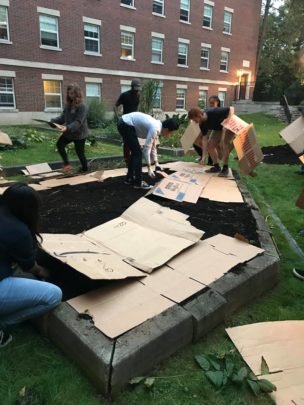Tucked on a sunken piece of land behind Gilbert residence hall, six garden beds
are part of one of the U of R’s greatest hidden treasures. You may not notice much from
Joseph C. Wilson Boulevard, but the EcoRep program has been steadily working to
revive the land for the past couple years. They hope to create a space for the campus
community, including “Big Booty Judy,” a popular local groundhog lovingly named by
the residents of Gilbert, and her other animal friends.
 The Gilbert Gardens have been an on-again, off-again project, and revived when
The Gilbert Gardens have been an on-again, off-again project, and revived when
the EcoRep garden committee formed in 2016. Maxwell Sheldon, part of the original
garden committee and later going on to become an EcoRep coordinator with Rosemary
Aviste, explained that the project is a result of a good working relationship between the
EcoReps, Grounds Crew, Maintenance, Res Life, and Dining Services. It began as a
pollinator garden, and used compost provided from Grounds that was received from
Waste Management and contained compostable materials from Dining Service, as well
as a borrowed rotating tilling machine, to help amend the soil.
The garden really took off the following year: the EcoReps looked into
permaculture design to begin producing food, and to serve as an educational
opportunity for students. A Support and Infrastructure Committee was formed in order to
reclaim wood and old construction materials for the garden, and the EcoReps used
“lasagna gardening” to layer old cardboard (from the mail center), compost (a bulldozer
load from Waste Management containing compostable materials from Dining Services),
and woodchips (donated from an outside organization) to prepare the beds. Max
explained that this became their “outdoor classroom,” and created a six-bed design
around the principles of permaculture and companion planting. They even took initiative
to design a website and give tours of the space. Partially funded through an RCCL
grant, plants and mushroom spawns were purchased and implemented with the help of
Rochester urban agriculturists and permaculture designers Patty Love and Stefanie
Benway. Because the space is surrounded on three sides by Gilbert, the beds have
limited exposure to sunlight. But as Max told me, “with limitations come a lot of
opportunities,” and the team set about tracking patterns of sunlight across the garden.
 This year holds a lot of potential for the Gilbert Gardens. The committee is
This year holds a lot of potential for the Gilbert Gardens. The committee is
currently busy ordering signs and labels for the beds, and has had more meetings with
facilities to build up their infrastructure. They will now have access to a master water
key and a spicket (a hose doesn’t do much good without a water source, afterall). Other
potential projects include repairing and installing bird houses, designing a horizontal
toolbox for storage, and purchasing a closed composter for the site. Max hopes that
getting a picnic table will help to create a vibrant and social space for students, as well.
Through work with the directors of Housing, Grounds, Res LIfe, and even the Fire
Marshall, the garden crew have been able to present a potential 5 year plan for the
space. The newest development will allow the EcoReps to uproot the six beds and
convert it into one large bed, which means permaculture patterns can be more
holistically integrated with one another.
Max calls this space the “Front Door of the University,” and though he
understands the urge to maintain a certain aesthetic on campus, the gardens can serve
as an important bridge for community engagement. The EcoReps’ Community
Engagement committee is currently working with the urban agriculture site, Grow
Green, which is located in the South West Area Neighborhood (SWAN). Their work
brings together students and community members to exchange knowledge and
resources about gardening, and form a desperately needed, reciprocal relationship
between the U of R and surrounding neighborhoods.
So what grows behind Gilbert? Right now the gardens are planted with potatoes,
tomatoes, swiss chard, raspberries, black raspberries (yes they’re a real thing),
gooseberries, and more. Native plants such as bleeding heart flower and hellebore are
also fostered on the grounds, as well as “lots and lots of clover.” Along with the plants
are several animal and insect friends that are important to a flourishing ecosystem, such
as birds, groundhogs, and rabbits, who all feast on the products of the garden (as did
Max for a summer). The EcoReps don’t see these animals as pests, however. Max
says, “in our eyes, they enrich the biodiversity of the space.” So next time you walk by,
check out the space! And when you do, make sure to send my love to Big Booty Judy.
The description for the Gilbert Garden reads: A permaculture initiative on the UR
campus aimed at providing a functional outdoor classroom for students and faculty to
learn about creating and sustaining ecosystems as well as the benefits of biodiversity.
Our overarching goal is to provide an alternative to the industrial foodscape that
dominates the UR and show that opting out of the system can be a reality.
Go green with Dining Team Green! Want more information on sustainability in dining? Follow us on Facebook, Instagram, and Twitter @ursustainibble. Contact us at urdiningteamgreen@gmail.com. We’d love to hear from you!
Guest Post Written by Sophia McRae, Class of 2019, Dining Team Green Sustainability Intern


I took away a lot of very good points from this post and will definitely save it in my bookmarks. Thanks for the effort you took to elaborate on this subject so thoroughly.
these students are doing a great job by cleaning their campus and believe me it gives you great satisfaction if you do so.